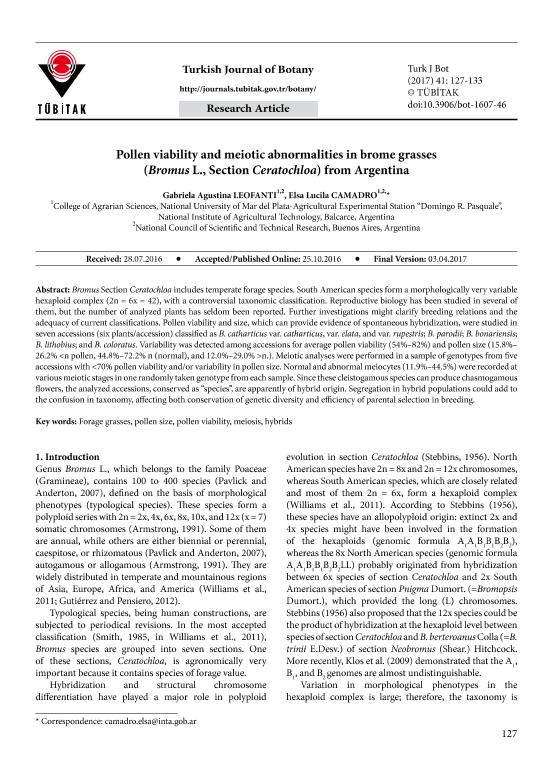Mostrar el registro sencillo del ítem
dc.contributor.author
Leofanti, Gabriela Agustina

dc.contributor.author
Camadro, Elsa Lucila

dc.date.available
2019-12-09T19:35:41Z
dc.date.issued
2016-10
dc.identifier.citation
Leofanti, Gabriela Agustina; Camadro, Elsa Lucila; Pollen viability and meiotic abnormalities in brome grasses (Bromus L., section Ceratochloa) from Argentina; Tubitak Scientific & Technical Research Council Turkey; Turkish Journal of Botany; 41; 2; 10-2016; 127-133
dc.identifier.issn
1300-008X
dc.identifier.uri
http://hdl.handle.net/11336/91767
dc.description.abstract
Bromus Section Ceratochloa includes temperate forage species. South American species form a morphologically very variable hexaploid complex (2n = 6x = 42), with a controversial taxonomic classification. Reproductive biology has been studied in several of them, but the number of analyzed plants has seldom been reported. Further investigations might clarify breeding relations and the adequacy of current classifications. Pollen viability and size, which can provide evidence of spontaneous hybridization, were studied in seven accessions (six plants/accession) classified as B. catharticus var. catharticus, var. elata, and var. rupestris; B. parodii; B. bonariensis; B. lithobius; and B. coloratus. Variability was detected among accessions for average pollen viability (54%–82%) and pollen size (15.8%– 26.2% n.). Meiotic analyses were performed in a sample of genotypes from five accessions with <70% pollen viability and/or variability in pollen size. Normal and abnormal meiocytes (11.9%–44.5%) were recorded at various meiotic stages in one randomly taken genotype from each sample. Since these cleistogamous species can produce chasmogamous flowers, the analyzed accessions, conserved as “species”, are apparently of hybrid origin. Segregation in hybrid populations could add to the confusion in taxonomy, affecting both conservation of genetic diversity and efficiency of parental selection in breeding.
dc.format
application/pdf
dc.language.iso
eng
dc.publisher
Tubitak Scientific & Technical Research Council Turkey

dc.rights
info:eu-repo/semantics/openAccess
dc.rights.uri
https://creativecommons.org/licenses/by-nc-sa/2.5/ar/
dc.subject
FORAGE GRASSES
dc.subject
HYBRIDS
dc.subject
MEIOSIS
dc.subject
POLLEN SIZE
dc.subject
POLLEN VIABILITY
dc.subject.classification
Genética y Herencia

dc.subject.classification
Ciencias Biológicas

dc.subject.classification
CIENCIAS NATURALES Y EXACTAS

dc.title
Pollen viability and meiotic abnormalities in brome grasses (Bromus L., section Ceratochloa) from Argentina
dc.type
info:eu-repo/semantics/article
dc.type
info:ar-repo/semantics/artículo
dc.type
info:eu-repo/semantics/publishedVersion
dc.date.updated
2019-12-05T18:03:27Z
dc.identifier.eissn
1303-6106
dc.journal.volume
41
dc.journal.number
2
dc.journal.pagination
127-133
dc.journal.pais
Turquía

dc.description.fil
Fil: Leofanti, Gabriela Agustina. Consejo Nacional de Investigaciones Científicas y Técnicas; Argentina. Instituto Nacional de Tecnología Agropecuaria; Argentina. Universidad Nacional de Mar del Plata. Facultad de Ciencias Agrarias; Argentina
dc.description.fil
Fil: Camadro, Elsa Lucila. Consejo Nacional de Investigaciones Científicas y Técnicas; Argentina. Instituto Nacional de Tecnología Agropecuaria; Argentina. Universidad Nacional de Mar del Plata. Facultad de Ciencias Agrarias; Argentina
dc.journal.title
Turkish Journal of Botany

dc.relation.alternativeid
info:eu-repo/semantics/altIdentifier/url/http://journals.tubitak.gov.tr/botany/abstract.htm?id=20246
dc.relation.alternativeid
info:eu-repo/semantics/altIdentifier/doi/http://dx.doi.org/10.3906/bot-1607-46
Archivos asociados
